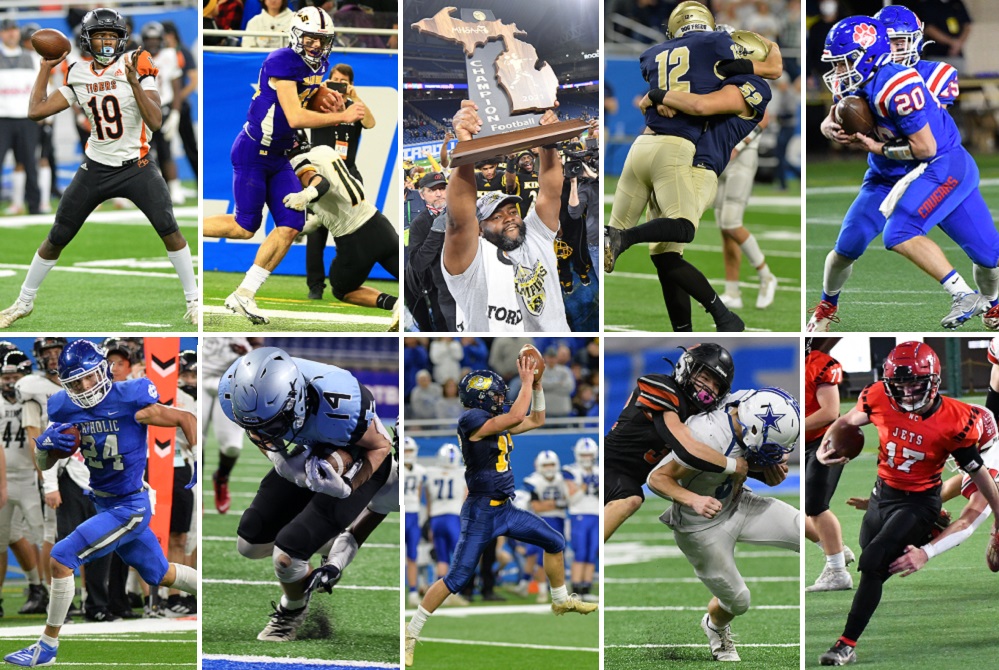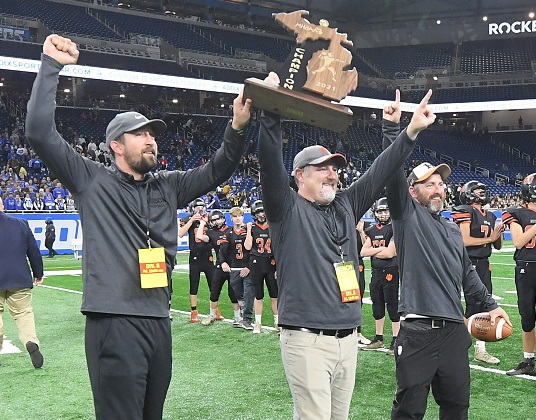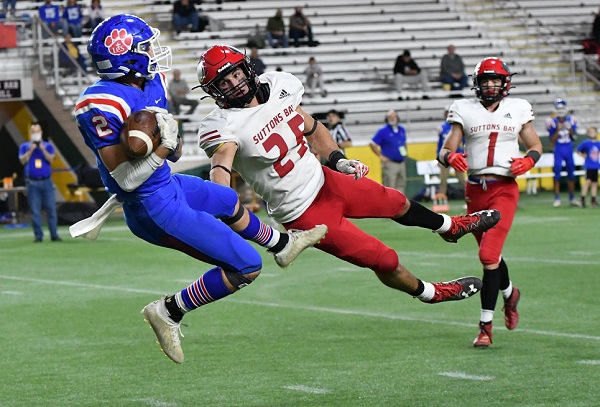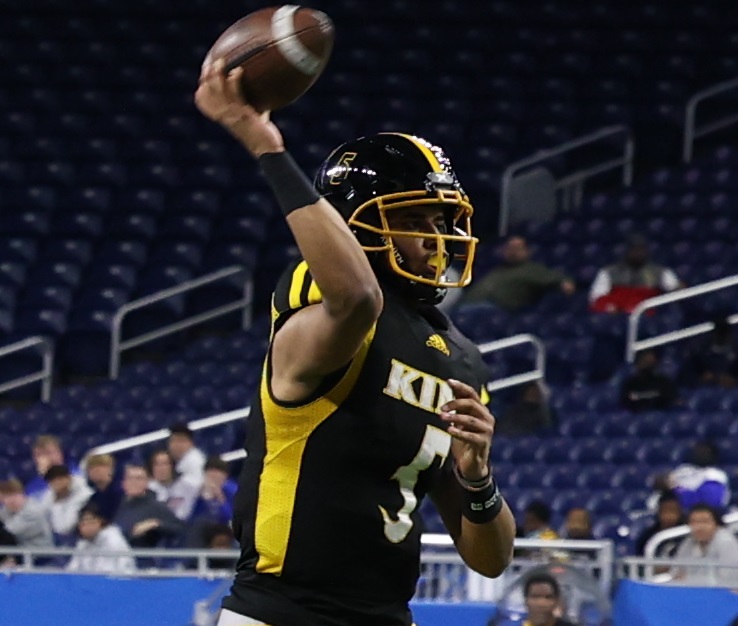
'22 Game' Lasts 2 Plays, Lives on
By
Ron Pesch
MHSAA historian
October 26, 2015
What would you do with 22 seconds to right a wrong?
In Michigan, the longest football game in high school sports history was played on September 23, 1977 when Detroit Southeastern defeated Detroit Northeastern 42-36 in nine overtimes.
But what is the shortest?
On the evening of Thursday, Nov. 5, 1953, Eaton County foes Bellevue and Vermontville squared off in a Tri-C Conference battle. It was a home contest for Vermontville, but without illumination at its field, the game was staged just west beneath the lights at Nashville High School in Barry County.
The dominant team in Tri-C play over the previous three years, Bellevue’s Broncos had posted three consecutive undefeated seasons from 1950 and 1952. However, graduation took its toll and with only five returning veterans in the fall of 1953, Bellevue lost its nonconference season opener to Homer. The Broncos had also dropped a pair of league contests, to Lake Odessa and Olivet, just prior to the Vermontville game, and entered with a 4-3 record.
Vermontville brought a 4-2 mark into the contest, and was in a four-way tie with Bellevue, Nashville and Lake Odessa for second in the conference.
The Broncos and Wildcats were evenly matched and played to a scoreless tie in the first half. Vermontville opened up a 6-0 lead on a 20-yard end sweep by the Wildcats’ quarterback Pete Benton in the third quarter, but entered the final minutes of the game trailing 12-6 thanks to a TD run by Bellevue’s Jim Smith and an early-fourth quarter scoring pass from Smith to Bob Babbitt.
Coach Dave McDowell’s Wildcats mounted a long final drive, and fans strapped in for a thrilling finish. Pushing deep into Bellevue territory, Vermontville faced a fourth down and eight from the 16-yard line with under a minute to play when Benton launched a desperation pass to the end zone.
The pass fell incomplete, but Bellevue was flagged for pass interference. Officials stepped off the penalty and awarded Vermontville the ball at the one-yard line, but the Wildcats’ plunge into the line fell an inch short on what was called a repeated fourth down play. Vermontville took possession and ran out the clock.
Following the game, Coach McDowell protested the ruling to officials, correctly stating that his team should have been awarded an automatic first down and goal from the 1-yard-line on the penalty, according to high school rules. Appealing the call, the situation was brought to the attention of the league, MHSAA executive director Charles Forsythe and the MHSAA athletic board.
On Wednesday, Nov. 11, the state athletic board agreed an error had been made, but did not order a replay. Instead, they noted three possible solutions:
- Result left as it was.
- Called a no contest.
- Replay it at the point of infraction.
The board moved a final decision back to the league. Because of the possible impact on the final conference standings, and eventually, the awarding of the league’s all-sports trophy, the Tri-C Conference opted to replay the contest from the point of infraction – the 1-yard line – with 22 seconds placed on the clock.
 The news of the league’s decision was blasted out by the news services nationwide, and immediately, the pending replay of a small town contest captured the imagination of reporters and sports fans across the United States.
The news of the league’s decision was blasted out by the news services nationwide, and immediately, the pending replay of a small town contest captured the imagination of reporters and sports fans across the United States.
“Shortest ‘Game’ in History?” read the headline in the Lexington, Kentucky Herald. From Biloxi, Mississippi, to Boston, Massachusetts, from Rockford, Illinois to Omaha, Nebraska and Seattle Washington, sports aficionados read the news about the error. Best of all, details flowed forth on the plan to replay critical seconds that might alter the result, fulfilling every fan’s dream.
So began the longest huddle in history.
“What would you do?” was the question on the lips of coaches and followers in barber shops and factories. Detroit Free Press writer George Puscas asked that very question to some of Michigan’s top coaches.
Detroit Lions coach Buddy Parker offered his advice to Vermontville’s coach McDowell.
“The other team will be expecting a run,” noted Parker, “so I would fake a run off tackle then throw a pass in the other direction – with three receivers downfield.”
Michigan State’s legendary Biggie Munn stated the obvious:
“Call a scoring play.”
University of Michigan head coach Bennie Oosterbaan was tied up preparing for the Wolverines’ upcoming contest with MSU, so instead U-M end coach Bill Orwig weighed in with a tongue-in-cheek recommendation:
“Take the time out.”
Earl “Dutch” Clark, in charge at the University of Detroit, suggested that McDowell diagram “two of the most unusual offensive formations … anything to confuse the defense. The first play should be a running play and if it didn’t work, take time out then try again.”
Wayne University’s coach Lou Zarza was the most specific of them all.
“On a goal line stand, the defense usually drifts toward the middle. So I would fake the ball to the right halfback on a slant, then send the fullback with the ball wide to the right, outflanking the defense. It’s a good goal line play on the T formation.”
Suggestions came from all over. A gentleman in Syracuse, New York, even penned a personal letter to McDowell with a sure-fire suggestion.
Three days after the 1953 prep season had officially ended, on the afternoon of Monday, Nov. 16, the same officiating crew and the Vermontville and Bellevue squads emerged and again travelled to Nashville to line up for what can arguably be called the shortest – or perhaps the longest – game in high school football history.
Reporters from Detroit, Grand Rapids, Lansing and Battle Creek converged on the city for 22 seconds of football. High school reporting legends Hal Schram of the Detroit Free Press, Bob Hoerner of the Lansing State Journal, George Maskin of the Detroit Times, Harry Stapler of the Detroit News and writers from the Associated Press and United Press International all descended upon mid-Michigan, “almost as if the Rose Bowl was to be played.”
“That game brought more publicity to coach Gordon Korstange’s 6-3 squad then his teams received for posting three consecutive unbeaten seasons in 1950, 1951 and 1952,” recalled 80-year old Burton H. Brooks, who was the only reporter who had covered the original contest, and one of many covering the replay. A graduate of Bellevue, he was a freshman at Michigan State at the time, earning money as a sports stringer for the Bellevue Gazette and Charlotte Republican Tribune.
Beneath sunny skies, “a crowd of over 500 fans and curiosity seekers, most of them attired in shirt sleeves, lined the field on both sides near the east end of the Nashville gridiron,” wrote Brooks, many years later. “At 5:00 the shrill blast of an official’s whistle split the air, announcing time for the game.”
Attendance was way up from the original contest, and in an unusual move for the time, Kalamazoo television station WKZO announced that they would send a crew to Nashville and then televise the game – (all 22 seconds of it!) – Tuesday evening. In addition, 10 newspaper photographers were on site to capture images from the game.
While the size of the crowd was up, turnout on the football squads had decreased. Vermontville dressed its full squad of 24 for the showdown, but kept out two regular tackles and his first-string quarterback, as all had been on the injured list at the end of the first clash.
Meanwhile, Bellevue brought only 14 players.
“Just our defensive unit and enough to run back the kickoff,” Korstange told the Lansing State Journal, prepared for a situation that could arise if Vermontville scored.
“Three of the defensive starters had decided to go deer hunting instead,” said Brooks discussing the shortened game, “so Bellevue needed to call up some kids for the game from the junior varsity squad.”
“Bellevue won its sixth game of the year, downing Vermontville in a sensational goal line stand in the famous ‘22’ Game” at Nashville last Monday,” wrote Brooks in the Bellevue Gazette. “Coach Dave McDowell’s Wildcats ran two plays against Bellevue, but couldn’t dent the solid Bronco defense. On the first play the Wildcats sent big Bob Steward up center, but he was driven back a yard by the entire center of the Bellevue line.”
 Following a timeout, the Green and White tried to sneak quarterback Pete Benton across the line to the left of center as the ball carrier on the second play, but the hole was quickly plugged by tackle Donald Rogers and guard Jerry Babbitt. Steward had been stopped by Bellevue guard Wayne Lesser. Dale Spotts, Bob Babbitt, Harold Messenger, Ralph Hales, Dick Moon, Jim Smith, Gordon Smith, and Ed Bessemer filled the other defensive spots and ensured the result of the first game went unchanged.
Following a timeout, the Green and White tried to sneak quarterback Pete Benton across the line to the left of center as the ball carrier on the second play, but the hole was quickly plugged by tackle Donald Rogers and guard Jerry Babbitt. Steward had been stopped by Bellevue guard Wayne Lesser. Dale Spotts, Bob Babbitt, Harold Messenger, Ralph Hales, Dick Moon, Jim Smith, Gordon Smith, and Ed Bessemer filled the other defensive spots and ensured the result of the first game went unchanged.
Once again, the wire services blasted their report from sea to shining sea.
“Officials Didn’t Rob Vermontville Team” screamed the headline in the Miami Daily News. Beneath an AP photo, residents of the Florida town were treated to a detailed account of the contest.
“Prep Grid Game Ends Same Way Following 11-Day Break” read the caption in the Dallas Morning News in football-crazed Texas.
“Replayed Grid Game Ends with the Same Result as Before,” read the headline in the Seattle, Washington, Daily Times.
As noted at the time, it certainly wasn’t the first, nor would it be the last, that a refereeing crew made a mistake in a game. Fans then, like now, were reminded officials are only human.
Bellevue ended the extended season in a tie for second with Lake Odessa, with 5-2 marks. For the first time in league history the Tri-C gridiron championship was awarded to Olivet, which, at 8-0, posted its first unbeaten season and, as it turned out, unseated Bellevue for the league’s 1953-54 all-sports trophy.
More than 60 years later, a forgotten showdown between high school football teams, played out before national attention in little Nashville, Michigan, still stands as one of the most entertaining and unusual sports moments in the history of America.
 Ron Pesch has taken an active role in researching the history of MHSAA events since 1985 and began writing for MHSAA Finals programs in 1986, adding additional features and "flashbacks" in 1992. He inherited the title of MHSAA historian from the late Dick Kishpaugh following the 1993-94 school year, and resides in Muskegon. Contact him at [email protected] with ideas for historical articles.
Ron Pesch has taken an active role in researching the history of MHSAA events since 1985 and began writing for MHSAA Finals programs in 1986, adding additional features and "flashbacks" in 1992. He inherited the title of MHSAA historian from the late Dick Kishpaugh following the 1993-94 school year, and resides in Muskegon. Contact him at [email protected] with ideas for historical articles.
PHOTOS: (Top and below) What's believed to be a Battle Creek Enquirer photo shows one of the goal line stands by the Bellevue defense against Vermontville. (Middle) The Lansing State Journal reported on the nationwide reporting of the "22-second game."

1st & Goal: 2021 Finals Review
By
Geoff Kimmerly
MHSAA.com senior editor
November 30, 2021
Two of the longest MHSAA Finals days at Ford Field – capped by two of the most exciting championship games in recent memory – concluded the 2021 football season this weekend.
 Fans were able to savor every moment until nearly midnight both nights, and more than 38,000 made the trip to Detroit over the two-day 11-player event. That was in addition to those who journeyed from near and far the weekend before for the 8-Player Finals at Northern Michigan University’s Superior Dome, where a pair of repeat champions reigned again.
Fans were able to savor every moment until nearly midnight both nights, and more than 38,000 made the trip to Detroit over the two-day 11-player event. That was in addition to those who journeyed from near and far the weekend before for the 8-Player Finals at Northern Michigan University’s Superior Dome, where a pair of repeat champions reigned again.
Second Half covered all 10 championship games, with quick recaps and links (click on the game scores) to those stories below followed by notations of performances entered into the MHSAA Finals record book and a report on some of the biggest and best stories to emerge from the championship weekends.

Finals in Review
11-Player Division 1: Belleville 55, Rochester Adams 33
After falling a win short of reaching the Final the last three seasons, Belleville advanced this fall and completed its first championship run. Freshman quarterback Bryce Underwood showed on a statewide stage why he’s received lots of attention during his high school debut, and he was surrounded by seniors including receiver Jeremiah Caldwell who helped carry the Tigers to the win.
11-Player Division 2: Warren De La Salle Collegiate 41, Traverse City Central 14
After falling in last season’s championship game, De La Salle took the next step in winning its fourth Finals title – and with expectations we could see the Pilots back at Ford Field again in 2022. Junior quarterback Brady Drogosh has been a big part of both trips, and this time he had a hand in 316 total yards and four touchdowns either running or passing.
11-Player Division 3: Detroit Martin Luther King 25, DeWitt 21
Two of the state’s premier quarterbacks were on display, junior Dante Moore for King and senior Ty Holtz for reigning champ DeWitt. But the deciding play was a defensive stand – specifically, the Crusaders stopping a 4th-and-goal from their 1-yard line with 2:34 to play. Both teams brought interceptions back for touchdowns, Holtz making the grab and score for DeWitt.
11-Player Division 4: Chelsea 55, Hudsonville Unity Christian 52
This is the game from this weekend many will be referring to years from now. Take your pick why – the 11-Player Finals record 107 combined points, Chelsea’s also-record 28-point comeback over the final 23 minutes, the fact Unity Christian had set the season record for points scored during the game. Maybe the walk-off field goal by Hunter Shaw saved in part by the deft handling of a short snap by quarterback/holder Lucas Dunn.
11-Player Division 5: Grand Rapids Catholic Central 31, Marine City 7
The Cougars won their second-straight championship in Division 5 and fifth over the last six seasons to go with Division 4 titles in 2016, 2017 and 2019. They did so with what has to be one of the finest back-up quarterbacking performances ever – senior John Passinault stepped in for injured past Finals star Joey Silveri and threw for 2,307 yards and 37 touchdowns this fall.
11-Player Division 6: Lansing Catholic 16, Warren Michigan Collegiate 6
The Cougars have been known for their offensive production over the last decade or more, but the defense led the way to their second championship in three seasons – they had won Division 5 in 2019. Lansing Catholic gave up only 40 points – or eight per game – during this playoff run, and in this game took advantage of four interceptions and a fumble recovery.
11-Player Division 7: Pewamo-Westphalia 14, Lawton 10
The Pirates added their fourth championship in six seasons, capping a run which saw them win their league and defeat eight more league champions along the way – one of them Lansing Catholic, the eventual Division 6 title winner. P-W had accomplished most of it with key players out with injuries, but multiple returned to lead the Pirates past Lawton, which was making its first Finals appearance.
11-Player Division 8: Hudson 14, Beal City 7
Defense has reigned in Division 8 the last few seasons, with Hudson following recent champions Centreville and Reading in thriving on that side of the ball. The Tigers ended their undefeated season having given up only 99 points (7.1 per game), and this time stopped a Beal City team averaging 35.5 points per contest entering Ford Field.
8-Player Division 1: Adrian Lenawee Christian 31, Suttons Bay 20
A rematch of last season’s Division 1 Final was more closely contested, but with the same result as Lenawee Christian finished its second-straight undefeated campaign. Cougars quarterback Ashur Bryja is a name to remember – he opened the scoring 51 seconds in with an interception return touchdown, ran for two more scores and threw for 229 yards.
8-Player Division 2: Powers North Central 63, Colon 0
The Jets won their second-straight Division 2 title and fourth 8-player championship total, and put up a combined 133 points over those last two Finals wins. North Central had 520 yards of total offense this time. Wyatt Raab, Luke Gorzinski and Alex Naser all scored two touchdowns, and Gorzinski also was the team’s leading tackler.

Records Report
11-Player
Chelsea and Hudsonville blew past the previous record of 94 combined points in an 11-Player Finals game with their combined 107. Chelsea’s 55 tied for third-most, with Unity Christian now sitting at sixth on that list after Belleville also scored 55 in Division 1.
As expected from a 55-52 game, Chelsea ended up with the fourth-most total yardage in 11-Player Finals history, with 533, and the teams’ combined total of 1,024 ranks second. Chelsea’s 28 first downs are tied for third-most.
Chelsea’s Lucas Hanifan tied 11-player championship game records with 30 points and five touchdowns, and set the receiving touchdowns record by two with that total. His quarterback Lucas Dunn set the 11-Player Finals record with six touchdown passes while also making the yardage list with 308, pass attempts list with 36 and completions list with 25. Hanifan’s nine receptions also rank among the most in that category.
Belleville freshman quarterback Bryce Underwood may have even exceeded high expectations with his Finals debut, making the total offense list with a combined 346 rushing and passing yards (with 284 passing) and tying for second with four others with five touchdown passes. Senior receiver Jeremiah Caldwell played a big part, tying for second with 204 receiving yards (on only four receptions) and also tying for second with three touchdown catches.
Warren De La Salle Collegiate became the 22nd team to keep an opponent from completing a pass, shutting out Traverse City Central on its nine attempts. Detroit Martin Luther King became the 29th team to not punt in an 11-Player Final.
De La Salle quarterback Brady Drogosh also made the total yardage list with 316 (including 174 rushing). King’s Dante Moore made the completions list with 18 on 24 attempts.
Chelsea’s Hunter Shaw and Belleville’s Brayden Lane tied the 11-Player Finals record held by three others with seven extra points, while in Division 2, De La Salle’s Brady Lowe made the extra point list with five. Shaw and Adams’ Colin Timko became the 11th and 12th, respectively, to make two or more field goals, Timko hitting from 27 and 35 yards in the Division 1 game and Shaw from 26 and 33.
Hudson’s march to victory included 282 rushing yards on 64 carries, which tied for the eighth-most runs by one team in an 11-Player Final.
8-Player
Powers North Central’s big win was accompanied by multiple scoring record book entries, including for 29 points in a quarter (third most), 49 in the first half (first) and 63 for one game (also ranking third). The Jets also made the team rushing yardage list with 328 and the team first downs list with 20. North Central also became the first in the category for fewest rushing yards allowed, holding Colon to -14.
Adrian Lenawee Christian set the team first downs record with 24 against Suttons Bay.
Lenawee Christian quarterback Ashur Bryja earned the sixth-most total yards in 8-Player Finals history, with 372 including 229 passing.
North Central’s Jaden Walters set the standard for 8-player championship game kickers, making all seven of his extra point attempts.
Suttons Bay’s August Schaub set a record that will be tough to match, returning an interception 99 yards for a touchdown against Lenawee Christian.
Teammate Hugh Periard was added with the second-longest rushing play in 8-Player Finals history, 90 yards against Lenawee Christian.

Stories Behind the Scores
Winning streaks grow: A few of this season’s winners not only repeated as champions, but extended overall winning streaks that will be followed closely next season. Grand Rapids Catholic Central has won 36 straight games, tied for the sixth-longest undefeated run. Lenawee Christian has won all 24 8-player games it’s played over the last two seasons, and North Central also is 24-0 over the last two.
What’s new is new: Belleville and Chelsea were first-time champions after some just-misses over the last decade. As noted above, the Tigers made the Semifinals this season for the fourth straight year before reaching Ford Field for the first time, and Chelsea has made the Semifinals five of the last seven seasons and had lost in Finals in 2015 and 2018.
QB Power: Michigan is graduating another fine class of high school quarterbacks – DeWitt’s Ty Holtz, in particular, provided two seasons of memories leading the Panthers on back-to-back trips to Ford Field. But we should expect to see some of the other 2021 championship signal-callers a lot next season. King’s Dante Moore will close one of the most highly-followed careers in some time, and De La Salle’s Brady Drogosh will be watched just as much next fall. Belleville’s Bryce Underwood will generate plenty of statewide interest over the next three seasons. As noted, Lenawee Christian’s Ashur Bryja is one of the next stars among the small schools, and North Central’s Luke Gorzinski has led two championship runs and still is just a junior. Two more to remember: Marine City junior Jeffery Heaslip was a standout run/pass threat in leading his team to the Division 5 Final, and Rochester Adams junior Parker Picot became known at least in-state as much for football leading his team in Division 1 as he’s known as a top-level baseball prospect.
No taking ‘normal’ for granted: Those who experienced the start-stop-start 2020 season will never forget it, nor should any of us who had the opportunity to enjoy a more “normal” 2021. With COVID-19 ever present, Michigan high schools did their parts again to play safely this fall. And proper perspective remains a great teacher of just how much that’s worth.
Second Half’s weekly “1st & Goal” previews and reviews are powered by MI Student Aid, a part of the Office of Postsecondary Financial Planning located within the Michigan Department of Treasury. MI Student Aid encourages students to pursue postsecondary education by providing access to student financial resources and information. MI Student Aid administers the state’s 529 college savings programs (MET/MESP), as well as scholarship and grant programs that help make college Accessible, Affordable and Attainable for you. Connect with MI Student Aid at www.michigan.gov/mistudentaid and find more information on Facebook and Twitter @mistudentaid.

